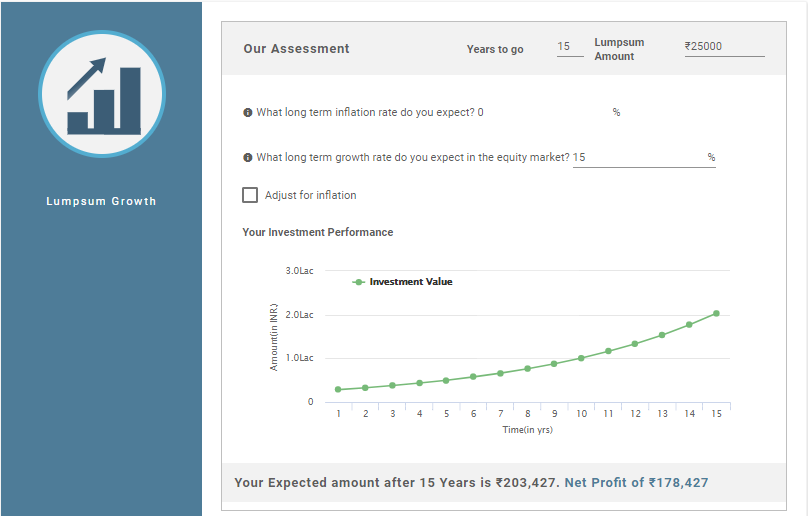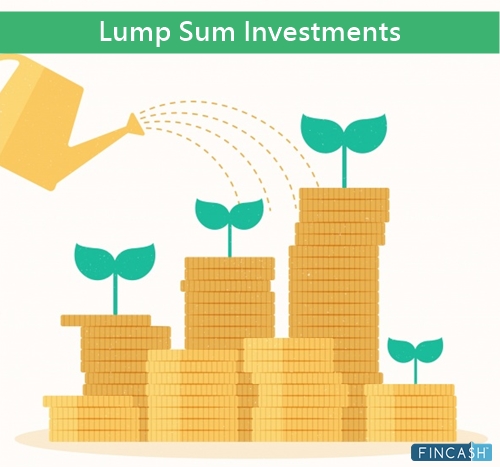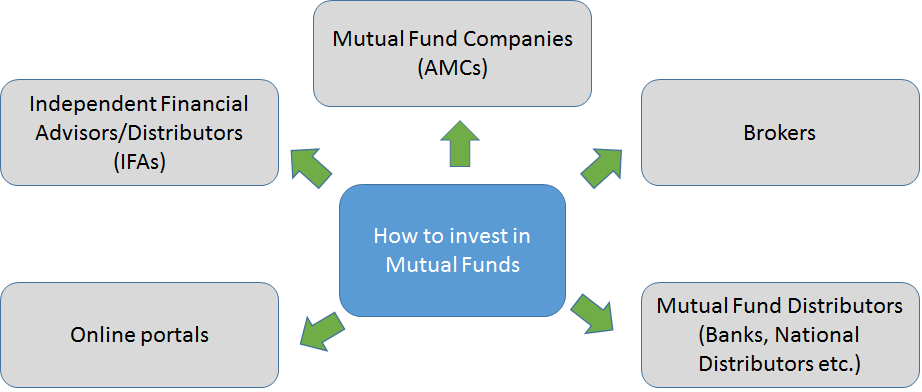Lump Sum Investment in Mutual Funds
Do you know that you can invest a lump sum amount in Mutual Funds? If yes, then it's good. However, if no, then don’t worry. This article will guide you through the same. Lump sum investment in Mutual Funds refers to a situation when an individual invests money in Mutual Funds at one-time. Here, the deposit does not take place at multiple times. There is a lot of difference between the SIP and lump sum mode of investment. So, let us understand the concept of Lump sum investment in Mutual Funds, best mutual funds for lump sum investment, things to be considered during lump sum investment, Mutual Fund Lump sum return calculator, and other related aspects through this article.

What do you mean by Lump Sum Investment in Mutual Funds?
Lump sum investment in Mutual Fund is a scenario where individuals invest in Mutual Funds for only once. However, in contrast to SIP mode of investment where individuals deposit small amounts in lump sum mode, individuals deposit a considerable amount. In other words, it is a one-shot technique of Investing in Mutual Funds. Lump sum mode of investing in suitable for investors who have excess funds that are lying ideal in their Bank account and are looking to for channels to earn more Income by investing in Mutual Funds.
Best Mutual Fund for Lump Sum Investment in 2025 – 2026
Before you invest in Mutual Funds through lump sum mode, individuals need to consider various parameters such as AUM, investment amount, and much more. So, based on these parameters some of the best Mutual Funds for Lump sum investment are as follows.
Best Lump Investment in Equity Mutual Funds
Equity Funds are the schemes that invest their corpus in equity and equity-related instruments of various companies. These schemes are considered to be a good option for long-term investment. Though individuals can invest lump sum amount in equity funds yet the recommended technique of investing in equity funds is either through SIP or Systematic Transfer Plan (STP) mode. In STP mode, individuals first deposit a considerable money in Debt fund such as Liquid Funds and then the money is transferred at regular intervals in equity funds. Some of the Equity Mutual Funds that can be considered for investment are as follows.
Fund NAV Net Assets (Cr) Min Investment 3 MO (%) 6 MO (%) 1 YR (%) 3 YR (%) 5 YR (%) 2024 (%) ICICI Prudential Infrastructure Fund Growth ₹192.6
↓ -0.95 ₹8,232 5,000 -2.3 -1.1 -0.5 23.5 29.7 27.4 SBI PSU Fund Growth ₹32.8349
↑ 0.10 ₹5,714 5,000 2 2.8 2.4 26.8 28.1 23.5 Motilal Oswal Midcap 30 Fund Growth ₹99.2431
↓ -0.73 ₹37,501 5,000 -6.6 -1.5 -13.2 24.1 28.1 57.1 HDFC Infrastructure Fund Growth ₹46.698
↓ -0.12 ₹2,586 5,000 -2.9 -1 -3.4 23.8 27.2 23 Nippon India Small Cap Fund Growth ₹163.954
↓ -0.89 ₹68,969 5,000 -4.9 -2.4 -9.2 20.1 27.2 26.1 Note: Returns up to 1 year are on absolute basis & more than 1 year are on CAGR basis. as on 17 Dec 25 Research Highlights & Commentary of 5 Funds showcased
Commentary ICICI Prudential Infrastructure Fund SBI PSU Fund Motilal Oswal Midcap 30 Fund HDFC Infrastructure Fund Nippon India Small Cap Fund Point 1 Lower mid AUM (₹8,232 Cr). Bottom quartile AUM (₹5,714 Cr). Upper mid AUM (₹37,501 Cr). Bottom quartile AUM (₹2,586 Cr). Highest AUM (₹68,969 Cr). Point 2 Oldest track record among peers (20 yrs). Established history (15+ yrs). Established history (11+ yrs). Established history (17+ yrs). Established history (15+ yrs). Point 3 Rating: 3★ (upper mid). Rating: 2★ (bottom quartile). Rating: 3★ (lower mid). Rating: 3★ (bottom quartile). Top rated. Point 4 Risk profile: High. Risk profile: High. Risk profile: Moderately High. Risk profile: High. Risk profile: Moderately High. Point 5 5Y return: 29.68% (top quartile). 5Y return: 28.06% (upper mid). 5Y return: 28.06% (lower mid). 5Y return: 27.23% (bottom quartile). 5Y return: 27.16% (bottom quartile). Point 6 3Y return: 23.51% (bottom quartile). 3Y return: 26.83% (top quartile). 3Y return: 24.10% (upper mid). 3Y return: 23.77% (lower mid). 3Y return: 20.07% (bottom quartile). Point 7 1Y return: -0.49% (upper mid). 1Y return: 2.42% (top quartile). 1Y return: -13.24% (bottom quartile). 1Y return: -3.40% (lower mid). 1Y return: -9.23% (bottom quartile). Point 8 Alpha: 0.00 (top quartile). Alpha: -0.58 (lower mid). Alpha: -4.22 (bottom quartile). Alpha: 0.00 (upper mid). Alpha: -2.66 (bottom quartile). Point 9 Sharpe: 0.00 (upper mid). Sharpe: 0.09 (top quartile). Sharpe: -0.13 (lower mid). Sharpe: -0.15 (bottom quartile). Sharpe: -0.35 (bottom quartile). Point 10 Information ratio: 0.00 (upper mid). Information ratio: -0.57 (bottom quartile). Information ratio: 0.20 (top quartile). Information ratio: 0.00 (lower mid). Information ratio: -0.11 (bottom quartile). ICICI Prudential Infrastructure Fund
SBI PSU Fund
Motilal Oswal Midcap 30 Fund
HDFC Infrastructure Fund
Nippon India Small Cap Fund
Talk to our investment specialist
Best Lump Sum Investment in Debt Mutual Funds
Debt Funds invest their fund money in different Fixed Income instruments like treasury bills, corporate Bonds, and much more. These schemes are considered as a good option for short and medium term. Many individuals choose to invest lump sum money in Debt Mutual Funds. Some of the Best Debt Funds that can be chosen for lump sum investment are as follows.
Fund NAV Net Assets (Cr) Min Investment 3 MO (%) 6 MO (%) 1 YR (%) 3 YR (%) 2024 (%) Debt Yield (YTM) Mod. Duration Eff. Maturity DSP Credit Risk Fund Growth ₹50.6785
↓ -0.01 ₹208 1,000 1.1 2.1 21 14.6 7.8 7.1% 2Y 29D 2Y 10M 24D Franklin India Credit Risk Fund Growth ₹25.3348
↑ 0.04 ₹104 5,000 2.9 5 7.5 11 0% Aditya Birla Sun Life Credit Risk Fund Growth ₹23.2337
↓ -0.01 ₹1,073 1,000 2 4.3 13.3 10.7 11.9 7.74% 2Y 1M 13D 3Y 1M 13D Invesco India Credit Risk Fund Growth ₹1,979.97
↓ -0.04 ₹153 5,000 1.4 2.4 9.2 9.4 7.3 6.79% 2Y 3M 22D 3Y 29D Aditya Birla Sun Life Medium Term Plan Growth ₹41.1278
↓ -0.01 ₹2,807 1,000 1.7 3.1 10.8 9.3 10.5 7.63% 3Y 8M 23D 5Y 29D Note: Returns up to 1 year are on absolute basis & more than 1 year are on CAGR basis. as on 17 Dec 25 Research Highlights & Commentary of 5 Funds showcased
Commentary DSP Credit Risk Fund Franklin India Credit Risk Fund Aditya Birla Sun Life Credit Risk Fund Invesco India Credit Risk Fund Aditya Birla Sun Life Medium Term Plan Point 1 Lower mid AUM (₹208 Cr). Bottom quartile AUM (₹104 Cr). Upper mid AUM (₹1,073 Cr). Bottom quartile AUM (₹153 Cr). Highest AUM (₹2,807 Cr). Point 2 Oldest track record among peers (22 yrs). Established history (14+ yrs). Established history (10+ yrs). Established history (11+ yrs). Established history (16+ yrs). Point 3 Top rated. Rating: 1★ (bottom quartile). Not Rated. Rating: 4★ (upper mid). Rating: 4★ (lower mid). Point 4 Risk profile: Moderate. Risk profile: Moderate. Risk profile: Moderate. Risk profile: Moderate. Risk profile: Moderate. Point 5 1Y return: 21.00% (top quartile). 1Y return: 7.45% (bottom quartile). 1Y return: 13.35% (upper mid). 1Y return: 9.22% (bottom quartile). 1Y return: 10.81% (lower mid). Point 6 1M return: 0.22% (bottom quartile). 1M return: 0.91% (top quartile). 1M return: 0.31% (lower mid). 1M return: 0.38% (upper mid). 1M return: 0.21% (bottom quartile). Point 7 Sharpe: 1.56 (lower mid). Sharpe: 0.29 (bottom quartile). Sharpe: 1.96 (upper mid). Sharpe: 1.22 (bottom quartile). Sharpe: 2.04 (top quartile). Point 8 Information ratio: 0.00 (top quartile). Information ratio: 0.00 (upper mid). Information ratio: 0.00 (lower mid). Information ratio: 0.00 (bottom quartile). Information ratio: 0.00 (bottom quartile). Point 9 Yield to maturity (debt): 7.10% (lower mid). Yield to maturity (debt): 0.00% (bottom quartile). Yield to maturity (debt): 7.74% (top quartile). Yield to maturity (debt): 6.79% (bottom quartile). Yield to maturity (debt): 7.63% (upper mid). Point 10 Modified duration: 2.08 yrs (upper mid). Modified duration: 0.00 yrs (top quartile). Modified duration: 2.12 yrs (lower mid). Modified duration: 2.31 yrs (bottom quartile). Modified duration: 3.73 yrs (bottom quartile). DSP Credit Risk Fund
Franklin India Credit Risk Fund
Aditya Birla Sun Life Credit Risk Fund
Invesco India Credit Risk Fund
Aditya Birla Sun Life Medium Term Plan
Best Hybrid Funds for Lump Sum Investment
Hybrid funds also known as Balanced Fund invest their money in both equity and fixed income instruments. These schemes are suitable for individuals looking for Capital generation along with regular income. Also known as balanced schemes, individuals can choose to invest lump sum amount in hybrid schemes. Some of the best hybrid funds for lump sum investment are listed below.
Fund NAV Net Assets (Cr) Min Investment 3 MO (%) 6 MO (%) 1 YR (%) 3 YR (%) 5 YR (%) 2024 (%) UTI Multi Asset Fund Growth ₹78.6516
↓ -0.10 ₹6,376 5,000 3.4 6.5 8.7 19.4 15.1 20.7 ICICI Prudential Multi-Asset Fund Growth ₹810.679
↓ -4.24 ₹71,900 5,000 3.9 7 14.5 19.1 21.5 16.1 ICICI Prudential Equity and Debt Fund Growth ₹407.96
↓ -0.61 ₹48,071 5,000 1.1 5.3 10.3 18.9 21.7 17.2 SBI Multi Asset Allocation Fund Growth ₹64.5242
↑ 0.04 ₹11,306 5,000 6.2 9.5 15.4 17.5 14.6 12.8 HDFC Balanced Advantage Fund Growth ₹529.178
↓ -0.67 ₹106,494 5,000 1.2 2.6 4.3 17.4 19.6 16.7 Note: Returns up to 1 year are on absolute basis & more than 1 year are on CAGR basis. as on 17 Dec 25 Research Highlights & Commentary of 5 Funds showcased
Commentary UTI Multi Asset Fund ICICI Prudential Multi-Asset Fund ICICI Prudential Equity and Debt Fund SBI Multi Asset Allocation Fund HDFC Balanced Advantage Fund Point 1 Bottom quartile AUM (₹6,376 Cr). Upper mid AUM (₹71,900 Cr). Lower mid AUM (₹48,071 Cr). Bottom quartile AUM (₹11,306 Cr). Highest AUM (₹106,494 Cr). Point 2 Established history (17+ yrs). Established history (23+ yrs). Oldest track record among peers (26 yrs). Established history (20+ yrs). Established history (25+ yrs). Point 3 Rating: 1★ (bottom quartile). Rating: 2★ (bottom quartile). Top rated. Rating: 4★ (upper mid). Rating: 4★ (lower mid). Point 4 Risk profile: Moderately High. Risk profile: Moderately High. Risk profile: Moderately High. Risk profile: Moderate. Risk profile: Moderately High. Point 5 5Y return: 15.11% (bottom quartile). 5Y return: 21.47% (upper mid). 5Y return: 21.70% (top quartile). 5Y return: 14.55% (bottom quartile). 5Y return: 19.57% (lower mid). Point 6 3Y return: 19.43% (top quartile). 3Y return: 19.07% (upper mid). 3Y return: 18.87% (lower mid). 3Y return: 17.53% (bottom quartile). 3Y return: 17.43% (bottom quartile). Point 7 1Y return: 8.66% (bottom quartile). 1Y return: 14.47% (upper mid). 1Y return: 10.34% (lower mid). 1Y return: 15.38% (top quartile). 1Y return: 4.35% (bottom quartile). Point 8 1M return: 0.04% (lower mid). 1M return: 0.58% (upper mid). 1M return: -0.53% (bottom quartile). 1M return: 1.22% (top quartile). 1M return: -1.24% (bottom quartile). Point 9 Alpha: 0.00 (upper mid). Alpha: 0.00 (lower mid). Alpha: 2.46 (top quartile). Alpha: 0.00 (bottom quartile). Alpha: 0.00 (bottom quartile). Point 10 Sharpe: 0.24 (bottom quartile). Sharpe: 0.86 (top quartile). Sharpe: 0.36 (lower mid). Sharpe: 0.70 (upper mid). Sharpe: -0.02 (bottom quartile). UTI Multi Asset Fund
ICICI Prudential Multi-Asset Fund
ICICI Prudential Equity and Debt Fund
SBI Multi Asset Allocation Fund
HDFC Balanced Advantage Fund
Best Index Funds for Lump Sum Investment
The Portfolio of an index fund consists of the shares and other instruments in the same proportion as they are in the index. In other words, these schemes mimic the performance of an index. These are passively managed funds and can be considered as a good option for lump sum investment. Some of the best Index Funds that can be chosen for lump sum investment are as follows.
Fund NAV Net Assets (Cr) 3 MO (%) 6 MO (%) 1 YR (%) 3 YR (%) 5 YR (%) 2024 (%) Nippon India Index Fund - Sensex Plan Growth ₹43.0727
↓ -0.06 ₹957 2.3 4.1 5.5 12 13.2 8.9 LIC MF Index Fund Sensex Growth ₹158.031
↓ -0.23 ₹92 2.1 3.7 4.9 11.4 12.6 8.2 Franklin India Index Fund Nifty Plan Growth ₹208.492
↓ -0.34 ₹775 2 4.3 6.8 12.8 13.9 9.5 IDBI Nifty Index Fund Growth ₹36.2111
↓ -0.02 ₹208 9.1 11.9 16.2 20.3 11.7 Nippon India Index Fund - Nifty Plan Growth ₹43.8508
↓ -0.07 ₹2,864 2 4.3 6.9 12.9 13.9 9.4 Note: Returns up to 1 year are on absolute basis & more than 1 year are on CAGR basis. as on 17 Dec 25 Research Highlights & Commentary of 5 Funds showcased
Commentary Nippon India Index Fund - Sensex Plan LIC MF Index Fund Sensex Franklin India Index Fund Nifty Plan IDBI Nifty Index Fund Nippon India Index Fund - Nifty Plan Point 1 Upper mid AUM (₹957 Cr). Bottom quartile AUM (₹92 Cr). Lower mid AUM (₹775 Cr). Bottom quartile AUM (₹208 Cr). Highest AUM (₹2,864 Cr). Point 2 Established history (15+ yrs). Established history (23+ yrs). Oldest track record among peers (25 yrs). Established history (15+ yrs). Established history (15+ yrs). Point 3 Top rated. Rating: 1★ (upper mid). Rating: 1★ (lower mid). Rating: 1★ (bottom quartile). Rating: 1★ (bottom quartile). Point 4 Risk profile: Moderately High. Risk profile: Moderately High. Risk profile: Moderately High. Risk profile: Moderately High. Risk profile: Moderately High. Point 5 5Y return: 13.16% (lower mid). 5Y return: 12.62% (bottom quartile). 5Y return: 13.95% (top quartile). 5Y return: 11.74% (bottom quartile). 5Y return: 13.88% (upper mid). Point 6 3Y return: 12.01% (bottom quartile). 3Y return: 11.44% (bottom quartile). 3Y return: 12.78% (lower mid). 3Y return: 20.28% (top quartile). 3Y return: 12.86% (upper mid). Point 7 1Y return: 5.53% (bottom quartile). 1Y return: 4.85% (bottom quartile). 1Y return: 6.84% (lower mid). 1Y return: 16.16% (top quartile). 1Y return: 6.91% (upper mid). Point 8 1M return: -0.50% (upper mid). 1M return: -0.53% (lower mid). 1M return: -0.73% (bottom quartile). 1M return: 3.68% (top quartile). 1M return: -0.78% (bottom quartile). Point 9 Alpha: -0.50 (upper mid). Alpha: -1.15 (bottom quartile). Alpha: -0.59 (lower mid). Alpha: -1.03 (bottom quartile). Alpha: -0.48 (top quartile). Point 10 Sharpe: 0.07 (bottom quartile). Sharpe: 0.01 (bottom quartile). Sharpe: 0.11 (lower mid). Sharpe: 1.04 (top quartile). Sharpe: 0.12 (upper mid). Nippon India Index Fund - Sensex Plan
LIC MF Index Fund Sensex
Franklin India Index Fund Nifty Plan
IDBI Nifty Index Fund
Nippon India Index Fund - Nifty Plan
Best Mutual Funds based on Last 1 Month
"The primary investment objective of the Scheme is to seek capital appreciation by investing predominantly in units of MLIIF - WGF. The Scheme may, at the discretion of the Investment Manager, also invest in the units of other similar overseas mutual fund schemes, which may constitute a significant part of its corpus. The Scheme may also invest a certain portion of its corpus in money market securities and/or units of money market/liquid schemes of DSP Merrill Lynch Mutual Fund, in order to meet liquidity requirements from time to time. However, there is no assurance that the investment objective of the Scheme will be realized." Below is the key information for DSP World Gold Fund Returns up to 1 year are on The primary investment objective of the Scheme is to seek capital appreciation by investing predominantly in the units of BlackRock Global Funds – World Mining Fund. The Scheme may, at the discretion of the Investment Manager, also invest in the units of other similar overseas mutual fund schemes, which may
constitute a significant part of its corpus. The Scheme may also invest a certain portion of its corpus in money market securities and/or money market/liquid schemes of DSP BlackRock Mutual Fund, in order to meet liquidity requirements from time to time. Research Highlights for DSP World Mining Fund Below is the key information for DSP World Mining Fund Returns up to 1 year are on To generate returns that closely correspond to returns generated by Axis Gold ETF. Research Highlights for Axis Gold Fund Below is the key information for Axis Gold Fund Returns up to 1 year are on To provide returns that closely corresponds to returns provided by Invesco India Gold Exchange Traded Fund. Research Highlights for Invesco India Gold Fund Below is the key information for Invesco India Gold Fund Returns up to 1 year are on ICICI Prudential Regular Gold Savings Fund (the Scheme) is a fund of funds scheme with the primary objective to generate returns by investing in units of ICICI Prudential Gold Exchange Traded Fund (IPru Gold ETF).
However, there can be no assurance that the investment objectives of the Scheme will be realized. Research Highlights for ICICI Prudential Regular Gold Savings Fund Below is the key information for ICICI Prudential Regular Gold Savings Fund Returns up to 1 year are on 1. DSP World Gold Fund
DSP World Gold Fund
Growth Launch Date 14 Sep 07 NAV (16 Dec 25) ₹52.4374 ↑ 0.29 (0.55 %) Net Assets (Cr) ₹1,498 on 31 Oct 25 Category Equity - Global AMC DSP BlackRock Invmt Managers Pvt. Ltd. Rating ☆☆☆ Risk High Expense Ratio 1.41 Sharpe Ratio 1.83 Information Ratio -1.04 Alpha Ratio -4.16 Min Investment 1,000 Min SIP Investment 500 Exit Load 0-12 Months (1%),12 Months and above(NIL) Growth of 10,000 investment over the years.
Date Value 30 Nov 20 ₹10,000 30 Nov 21 ₹9,903 30 Nov 22 ₹8,659 30 Nov 23 ₹9,599 30 Nov 24 ₹12,026 30 Nov 25 ₹27,573 Returns for DSP World Gold Fund
absolute basis & more than 1 year are on CAGR (Compound Annual Growth Rate) basis. as on 16 Dec 25 Duration Returns 1 Month 15.6% 3 Month 28.6% 6 Month 66.2% 1 Year 149.9% 3 Year 49.4% 5 Year 22.9% 10 Year 15 Year Since launch 9.5% Historical performance (Yearly) on absolute basis
Year Returns 2024 15.9% 2023 7% 2022 -7.7% 2021 -9% 2020 31.4% 2019 35.1% 2018 -10.7% 2017 -4% 2016 52.7% 2015 -18.5% Fund Manager information for DSP World Gold Fund
Name Since Tenure Jay Kothari 1 Mar 13 12.68 Yr. Data below for DSP World Gold Fund as on 31 Oct 25
Equity Sector Allocation
Sector Value Basic Materials 95.15% Asset Allocation
Asset Class Value Cash 2.29% Equity 95.15% Debt 0.02% Other 2.54% Top Securities Holdings / Portfolio
Name Holding Value Quantity BGF World Gold I2
Investment Fund | -75% ₹1,127 Cr 1,347,933
↓ -108,097 VanEck Gold Miners ETF
- | GDX24% ₹367 Cr 573,719 Treps / Reverse Repo Investments
CBLO/Reverse Repo | -2% ₹23 Cr Net Receivables/Payables
Net Current Assets | -1% -₹20 Cr 2. DSP World Mining Fund
DSP World Mining Fund
Growth Launch Date 29 Dec 09 NAV (16 Dec 25) ₹26.1667 ↑ 0.13 (0.49 %) Net Assets (Cr) ₹169 on 31 Oct 25 Category Equity - Global AMC DSP BlackRock Invmt Managers Pvt. Ltd. Rating ☆☆☆ Risk High Expense Ratio 1.14 Sharpe Ratio 1.28 Information Ratio 0 Alpha Ratio 0 Min Investment 1,000 Min SIP Investment 500 Exit Load 0-12 Months (1%),12 Months and above(NIL) Growth of 10,000 investment over the years.
Date Value 30 Nov 20 ₹10,000 30 Nov 21 ₹12,339 30 Nov 22 ₹14,572 30 Nov 23 ₹13,637 30 Nov 24 ₹14,706 30 Nov 25 ₹21,988 Returns for DSP World Mining Fund
absolute basis & more than 1 year are on CAGR (Compound Annual Growth Rate) basis. as on 16 Dec 25 Duration Returns 1 Month 12.2% 3 Month 23.7% 6 Month 49.9% 1 Year 66.8% 3 Year 17.7% 5 Year 16.7% 10 Year 15 Year Since launch 6.2% Historical performance (Yearly) on absolute basis
Year Returns 2024 -8.1% 2023 0% 2022 12.2% 2021 18% 2020 34.9% 2019 21.5% 2018 -9.4% 2017 21.1% 2016 49.7% 2015 -36% Fund Manager information for DSP World Mining Fund
Name Since Tenure Jay Kothari 1 Mar 13 12.68 Yr. Data below for DSP World Mining Fund as on 31 Oct 25
Equity Sector Allocation
Sector Value Basic Materials 96.18% Energy 1.1% Asset Allocation
Asset Class Value Cash 2.35% Equity 97.28% Debt 0.01% Other 0.36% Top Securities Holdings / Portfolio
Name Holding Value Quantity BGF World Mining I2
Investment Fund | -99% ₹167 Cr 193,620
↓ -1,404 Treps / Reverse Repo Investments
CBLO/Reverse Repo | -1% ₹2 Cr Net Receivables/Payables
Net Current Assets | -0% ₹0 Cr 3. Axis Gold Fund
Axis Gold Fund
Growth Launch Date 20 Oct 11 NAV (17 Dec 25) ₹38.5441 ↑ 0.24 (0.63 %) Net Assets (Cr) ₹1,800 on 31 Oct 25 Category Gold - Gold AMC Axis Asset Management Company Limited Rating ☆ Risk Moderately High Expense Ratio 0.5 Sharpe Ratio 2.43 Information Ratio 0 Alpha Ratio 0 Min Investment 5,000 Min SIP Investment 1,000 Exit Load 0-1 Years (1%),1 Years and above(NIL) Growth of 10,000 investment over the years.
Date Value 30 Nov 20 ₹10,000 30 Nov 21 ₹9,776 30 Nov 22 ₹10,573 30 Nov 23 ₹12,492 30 Nov 24 ₹15,037 30 Nov 25 ₹24,261 Returns for Axis Gold Fund
absolute basis & more than 1 year are on CAGR (Compound Annual Growth Rate) basis. as on 16 Dec 25 Duration Returns 1 Month 8.2% 3 Month 20.7% 6 Month 32.9% 1 Year 70% 3 Year 33.2% 5 Year 20.1% 10 Year 15 Year Since launch 10% Historical performance (Yearly) on absolute basis
Year Returns 2024 19.2% 2023 14.7% 2022 12.5% 2021 -4.7% 2020 26.9% 2019 23.1% 2018 8.3% 2017 0.7% 2016 10.7% 2015 -11.9% Fund Manager information for Axis Gold Fund
Name Since Tenure Aditya Pagaria 9 Nov 21 3.98 Yr. Pratik Tibrewal 1 Feb 25 0.75 Yr. Data below for Axis Gold Fund as on 31 Oct 25
Asset Allocation
Asset Class Value Cash 1.68% Other 98.32% Top Securities Holdings / Portfolio
Name Holding Value Quantity Axis Gold ETF
- | -100% ₹1,798 Cr 178,172,322
↑ 16,852,517 Clearing Corporation Of India Ltd
CBLO/Reverse Repo | -0% ₹9 Cr Net Receivables / (Payables)
CBLO | -0% -₹7 Cr 4. Invesco India Gold Fund
Invesco India Gold Fund
Growth Launch Date 5 Dec 11 NAV (17 Dec 25) ₹37.1374 ↑ 0.19 (0.50 %) Net Assets (Cr) ₹278 on 31 Oct 25 Category Gold - Gold AMC Invesco Asset Management (India) Private Ltd Rating ☆☆☆ Risk Moderately High Expense Ratio 0.37 Sharpe Ratio 2.4 Information Ratio 0 Alpha Ratio 0 Min Investment 5,000 Min SIP Investment 500 Exit Load 0-6 Months (2%),6-12 Months (1%),12 Months and above(NIL) Growth of 10,000 investment over the years.
Date Value 30 Nov 20 ₹10,000 30 Nov 21 ₹9,636 30 Nov 22 ₹10,509 30 Nov 23 ₹12,273 30 Nov 24 ₹14,833 30 Nov 25 ₹23,695 Returns for Invesco India Gold Fund
absolute basis & more than 1 year are on CAGR (Compound Annual Growth Rate) basis. as on 16 Dec 25 Duration Returns 1 Month 8.2% 3 Month 20.4% 6 Month 32.6% 1 Year 68.7% 3 Year 32.6% 5 Year 19.8% 10 Year 15 Year Since launch 9.8% Historical performance (Yearly) on absolute basis
Year Returns 2024 18.8% 2023 14.5% 2022 12.8% 2021 -5.5% 2020 27.2% 2019 21.4% 2018 6.6% 2017 1.3% 2016 21.6% 2015 -15.1% Fund Manager information for Invesco India Gold Fund
Name Since Tenure Abhisek Bahinipati 1 Nov 25 0 Yr. Data below for Invesco India Gold Fund as on 31 Oct 25
Asset Allocation
Asset Class Value Cash 4.15% Other 95.85% Top Securities Holdings / Portfolio
Name Holding Value Quantity Invesco India Gold ETF
- | -97% ₹271 Cr 258,048
↑ 24,628 Triparty Repo
CBLO/Reverse Repo | -3% ₹8 Cr Net Receivables / (Payables)
CBLO | -0% -₹1 Cr 5. ICICI Prudential Regular Gold Savings Fund
ICICI Prudential Regular Gold Savings Fund
Growth Launch Date 11 Oct 11 NAV (17 Dec 25) ₹41.0358 ↑ 0.23 (0.57 %) Net Assets (Cr) ₹3,770 on 31 Oct 25 Category Gold - Gold AMC ICICI Prudential Asset Management Company Limited Rating ☆ Risk Moderately High Expense Ratio 0.38 Sharpe Ratio 2.38 Information Ratio 0 Alpha Ratio 0 Min Investment 5,000 Min SIP Investment 100 Exit Load 0-15 Months (2%),15 Months and above(NIL) Growth of 10,000 investment over the years.
Date Value 30 Nov 20 ₹10,000 30 Nov 21 ₹9,688 30 Nov 22 ₹10,449 30 Nov 23 ₹12,281 30 Nov 24 ₹14,858 30 Nov 25 ₹24,046 Returns for ICICI Prudential Regular Gold Savings Fund
absolute basis & more than 1 year are on CAGR (Compound Annual Growth Rate) basis. as on 16 Dec 25 Duration Returns 1 Month 8% 3 Month 20.4% 6 Month 33.1% 1 Year 71.1% 3 Year 33.4% 5 Year 20% 10 Year 15 Year Since launch 10.5% Historical performance (Yearly) on absolute basis
Year Returns 2024 19.5% 2023 13.5% 2022 12.7% 2021 -5.4% 2020 26.6% 2019 22.7% 2018 7.4% 2017 0.8% 2016 8.9% 2015 -5.1% Fund Manager information for ICICI Prudential Regular Gold Savings Fund
Name Since Tenure Manish Banthia 27 Sep 12 13.1 Yr. Nishit Patel 29 Dec 20 4.84 Yr. Ashwini Bharucha 1 Nov 25 0 Yr. Venus Ahuja 1 Nov 25 0 Yr. Data below for ICICI Prudential Regular Gold Savings Fund as on 31 Oct 25
Asset Allocation
Asset Class Value Cash 1.4% Other 98.6% Top Securities Holdings / Portfolio
Name Holding Value Quantity ICICI Pru Gold ETF
- | -100% ₹3,768 Cr 364,653,102
↑ 33,144,958 Treps
CBLO/Reverse Repo | -1% ₹23 Cr Net Current Assets
Net Current Assets | -1% -₹21 Cr
Things to be Considered During Lump Sum Investment
Before investing in Mutual Funds individuals need to take care a lot of parameters. It includes:
Timing the Market
When it comes to lump sum investing, individuals need to always look for Market timings especially with respect to equity-based funds. A good timing to invest lump sum is when the markets are low and there’s a scope that they will start appreciating soon. However, in case if the markets are already at peak then, it is better to stay off from lump sum investment.
Diversification
Diversification is also an important aspect that needs to be considered before investing lump sum. Individuals in case of lump sum investment should diversify their investments by spreading into multiple avenues. This will help to ensure that their overall portfolio performs well even if one of the schemes doesn’t perform.
Do Your Investment as per Your Objective
Any investment that individuals do is to attain a particular objective. Therefore, individuals should check whether the scheme’s approach is in-line with the investor’s objective. Here, individuals should look for various parameters such as CAGR returns, Absolute returns, the impact of taxation and much more before investing in the scheme.
Redemption should be done at the Correct Time
Individuals should do their Redemption at the correct time in lump sum investment. Though it can be as per the investment objective yet; individuals should do a timely review of the scheme in which they are planning to invest. However, they also need to hold their investments for a longer duration so that they can enjoy maximum benefits.
Mutual Fund Lump Sum Return Calculator
Mutual Fund lump sum return calculator helps individuals to show how the lump sum investment of an individual grows over a given timeframe. Some of the data that needs to input in the lump sum calculator includes the tenure of the investment, initial investment amount, long-term expected growth rate and much more. An illustration of the Mutual Fund lump sum return calculator is as follows.
ILLUSTRATION
Lump Sum Investment: INR 25,000
Investment Tenure: 15 Years
Long-term Growth Rate (Approx.): 15%
Expected Returns as per Lump Sum Calculator: INR 2,03,427
Net Profit on the Investment: INR 1,78,427

Thus, the above calculation shows that the net profit on the investment on your investment is INR 1,78,427 while the total value of your investment is INR 2,03,427.
Advantages and Disadvantages of One-Time Investment in Mutual Fund
Similar to SIP, Lump Sum Investment also has its own set of advantages and disadvantages. So, let us look at these advantages and disadvantages.
Advantages
The advantages of Lump Sum investment are as follows.
- Invest Big Amount: Individuals can invest big amounts in Mutual Funds and earn higher returns instead of keeping the funds idle.
- Ideal for Long Term: Lump Sum mode of investment is good for long-term investments specially in case of equity funds. However, in case of debt funds, the tenure can be short or medium-term
- Convenience: Lump sum mode of investment is convenient as the payment is done only once and is not deducted at regular intervals.
Disadvantages
The disadvantages of Lump Sum investment are:
- Irregular Investment: Lump Sum investment does not ensure regular savings of an investor as it does not instil regular savings habit.
- Higher Risk: In Lump Sum investing, it is important to look at the timings. This is because in lump sum mode the investment is done only once and not at regular intervals. Therefore, if individuals do not consider the timing, then they might end up in losses.
Conclusion
Thus, from the above pointers, it can be said that lump sum mode is also a good way to invest in Mutual Funds. However, individuals need to be confident while investing a lump sum amount in the scheme. If not, they can choose SIP mode of investment. In addition, people should understand the scheme’s modalities before investing. If required, they can even consult a financial advisor. This will help them to ensure that their money is safe and their objectives are accomplished on time.
All efforts have been made to ensure the information provided here is accurate. However, no guarantees are made regarding correctness of data. Please verify with scheme information document before making any investment.













Research Highlights for DSP World Gold Fund